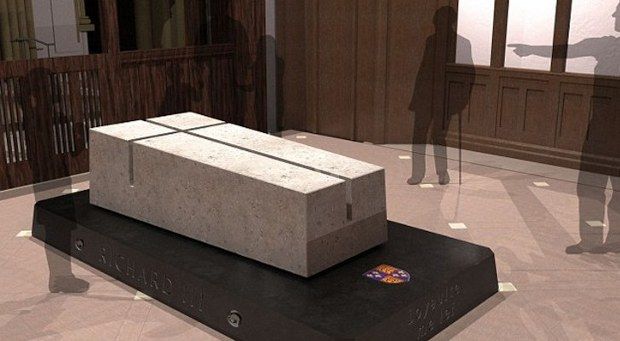King Richard III passed away in 1485 after having suffered severe wounds while taking part in a battle against Henry Tudor. He was buried in an undisclosed location, and for a long time, it was assumed that his body had forever been lost to history.
In 2012, however, his remains were quite by chance discovered under a parking lot in Leicester, England. The late monarch's skeleton was pulled from a small grave in the ground that looked anything but fit for royalty.
Not that this is any consolation to him, seeing how he's been dead for well over five centuries and, therefore, quite disconnected from his body, but before this month is over, Richard III will at long last get a burial fit for a king.
Thus, come Thursday, March 26, the monarch's skeletal remains will be buried in a tomb built especially for him at the Leicester Cathedral. The tomb, shown in the image below, will hopefully serve as King Richard III's final resting place.
The burial will be preceded by a funeral procession
Just yesterday, King Richard III's skeleton left the University of Leicester, where it was kept for about 2 years to be studied, tucked inside an oak coffin. Having visited the Bosworth battlefield where the monarch met his demise, the procession arrived at the Leicester Cathedral.
As mentioned, the king's second burial is scheduled to take place this coming Thursday, March 26. The service will begin at 7:30 a.m. EST (11:30 a.m. local time), and once Richard III is safe inside his new tomb, fireworks will be fired from atop his new cathedral home.
The tomb will be revealed to the public the day after, on March 27. Given how popular King Richard III has been in England since his body was found and pulled from the ground in 2012, chances are thousands will flock to Leicester to have a look at his final resting place.
How exactly did England's King Richard III die?
Having analyzed his skeletal remains, researchers with the University of Leicester in England discovered that, during the 1485 battle against Henry Tudor, King Richard III suffered a total of 11 wounds, some more severe than others.
Specifically, evidence indicates that, while on the battlefield, the monarch was stabbed repeatedly and even poked at with a sword and a halberd. The blow that killed him was given with a sharp weapon that entered his body at the base of his skull and sliced through his brain.
“Richard’s skeleton sustained 11 wounds at or near the time of his death - 9 of them to the skull, which were clearly inflicted in battle. The injuries to the head suggest he had either removed or lost his helmet,” specialist Sarah Hainsworth said in a statement.
For the time being, it is unclear who it was that killed the monarch. In fact, it's safe to assume that the identity of King Richard III's killer will forever remain a mystery. The one thing that's pretty obvious is that, whoever it was, they sure knew their way around a sword.

 14 DAY TRIAL //
14 DAY TRIAL // 

